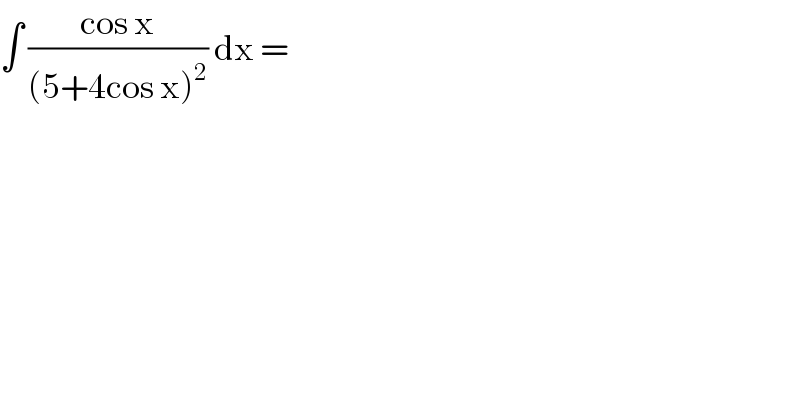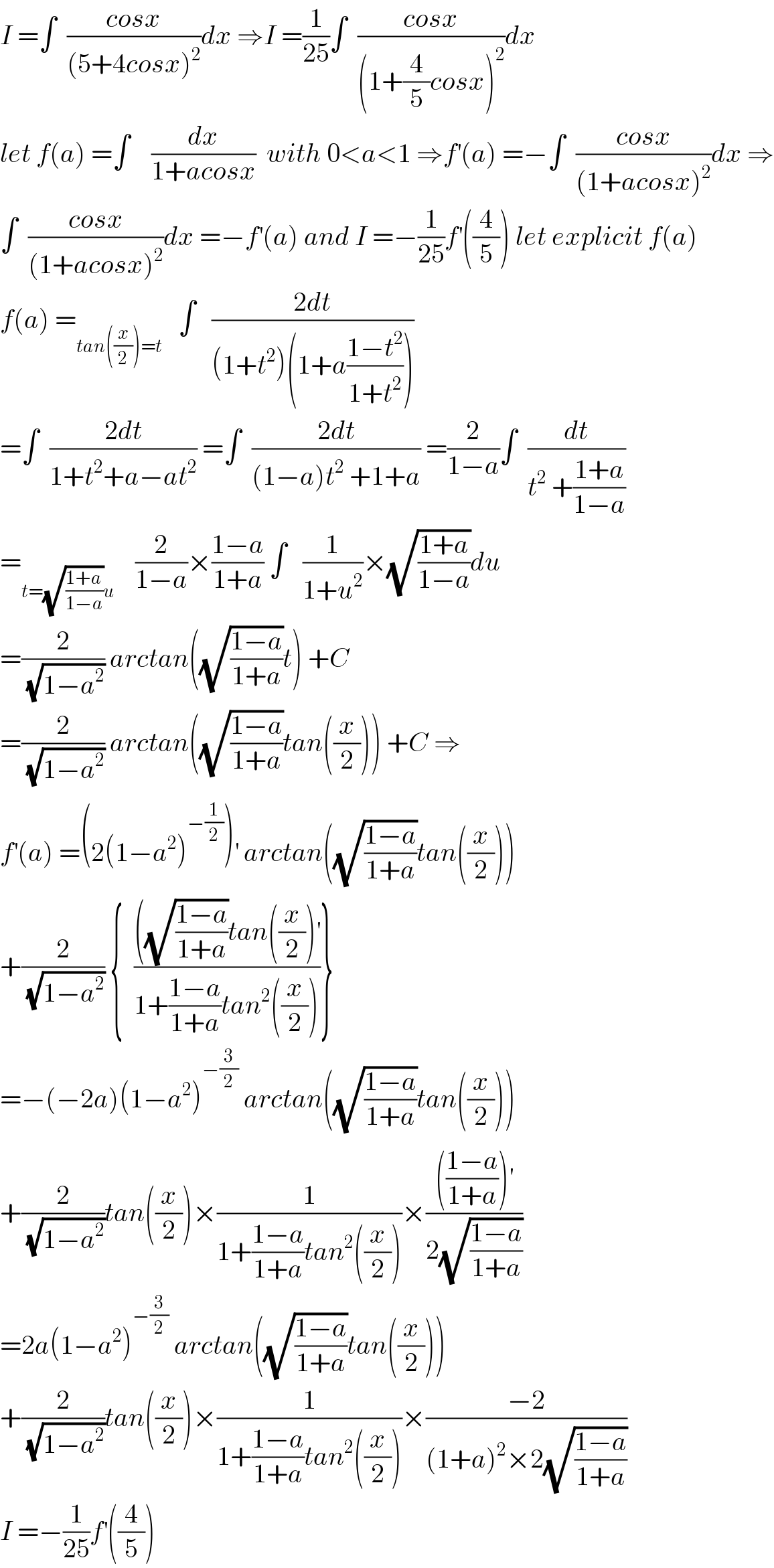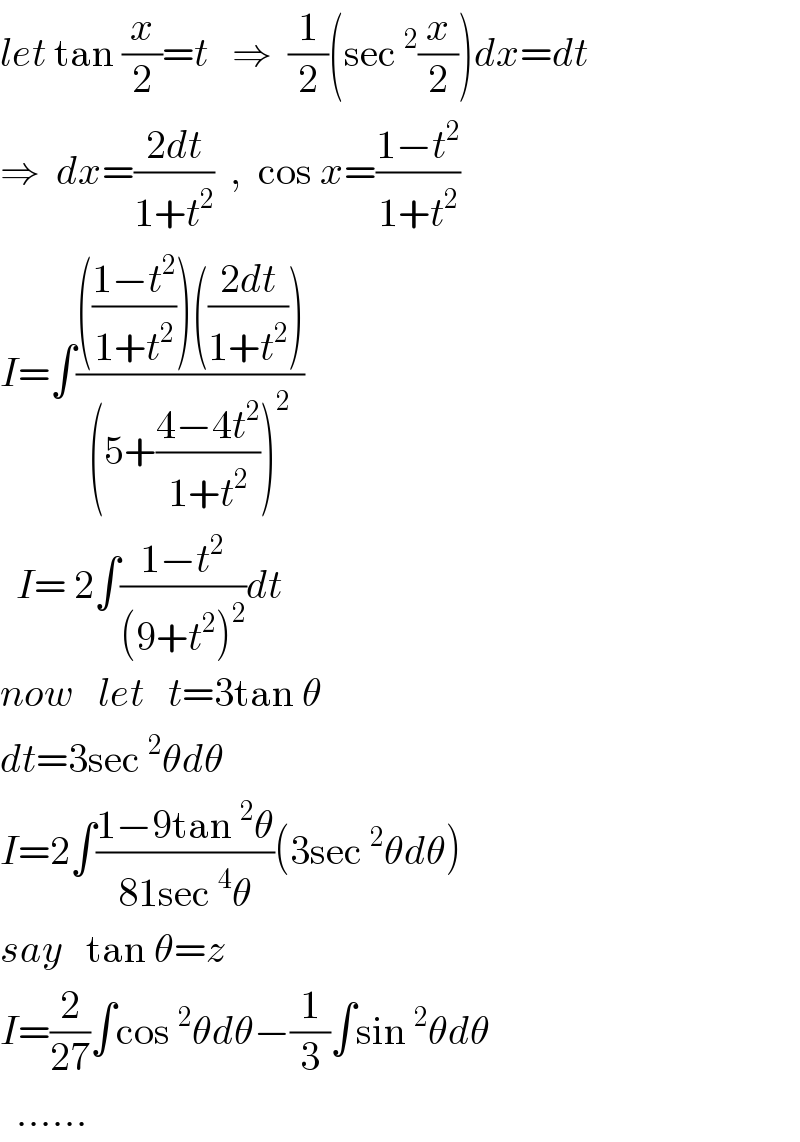
Question and Answers Forum
Question Number 87340 by john santu last updated on 04/Apr/20

Commented by john santu last updated on 04/Apr/20

Commented by MJS last updated on 04/Apr/20

Commented by mathmax by abdo last updated on 04/Apr/20

Answered by ajfour last updated on 04/Apr/20

Commented by jagoll last updated on 04/Apr/20

Commented by ajfour last updated on 04/Apr/20

Commented by jagoll last updated on 04/Apr/20

Commented by john santu last updated on 04/Apr/20

Commented by ajfour last updated on 04/Apr/20

Answered by TANMAY PANACEA. last updated on 04/Apr/20
![t=5+4cosx→cosx=((t−5)/4) (1/4)∫((4cosx+5−5)/((5+4cosx)^2 ))dx (1/4)∫(dx/(5+4cosx))−(5/4)∫(dx/((5+4cosx)^2 ))★ let I_1 =∫(dx/(5+4cosx)) and I_2 =∫(dx/((5+4cosx)^2 )) so I=(I_1 /4)−((5I_2 )/4).......eqn (1) p=((sinx)/(5+4cosx)) (dp/dx)=(((5+4cosx)cosx−sinx(−4sinx))/((5+4cosx)^2 )) (dp/dx)=((5cosx+4)/((5+4cosx)^2 ))=((((5(t−5))/4)+4)/t^2 )=((5t−9)/(4t^2 ))=(5/(4t))−(9/(4t^2 )) ((sinx)/(5+4cosx))=(5/4)∫(dx/(5+cosx))−(9/4)∫(dx/((5+4cosx)^2 )) now look ((sinx)/(5+4cosx))=((5I_1 )/4)−((9I_2 )/4)....eqn(2) [5I_1 −4(((sinx)/(5+cosx)))]×(1/9)=I_2 ■ look if we find the value of I_1 =∫(dx/(5+4cosx)) then from eqn(2) we get value of I_2 finaly we get I=(I_1 /4)−((5I_2 )/4)■ ∫(dx/(5+4cosx))=∫((sec^2 (x/2))/(5+5tan^2 (x/2)+4−4tan^2 (x/2)))dx=∫((sec^2 (x/2))/(tan^2 (x/2)+3^2 )) =2∫((d(tan(x/2)))/(3^2 +tan^2 (x/2)))dx=2×(1/3)tan^(−1) (((tan(x/2))/3))+c_1 = I_1 =(2/3)tan^(−1) (((tan(x/2))/3)) I_2 =(1/9)[5I_1 −((4sinx)/(5+4cosx))] I_2 =(1/9)[((10)/3)tan^(−1) (((tan(x/2))/3))−((4sinx)/(5+4cosx))]^ finally I=(I_1 /4)−((5I_2 )/4)=(2/(12))tan^(−1) (((tan(x/2))/3))−(5/4)×(1/9)[((10)/3)tan^(−1) (((tan(x/2))/3))−((4sinx)/(5+4cosx))] I=((2/(12))−((50)/(108)))tan^(−1) (((tan(x/2))/3))+(5/(36))(((4sinx)/(5+4cosx)))+C](Q87403.png)
Commented by john santu last updated on 04/Apr/20

Commented by TANMAY PANACEA. last updated on 04/Apr/20

Answered by MJS last updated on 04/Apr/20
![Weierstrass is the fastest ∫((cos x)/((5+4cos x)^2 ))dx= [t=tan (x/2) → dx=(2/(t^2 +1))dt] =−2∫((t^2 −1)/((t^2 +9)^2 ))dt= =20∫(dt/((t^2 +9)^2 ))−2∫(dt/(t^2 +9))= =((10t)/(9(t^2 +9)))−(8/(27))arctan (t/3) = =((5sin x)/(9(5+4cos x)))−(8/(27))arctan ((tan (x/2))/3) +C](Q87454.png)
Commented by jagoll last updated on 04/Apr/20

